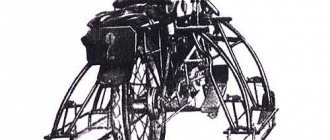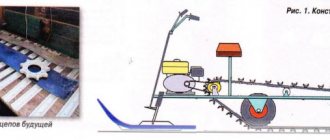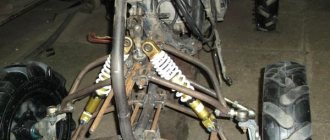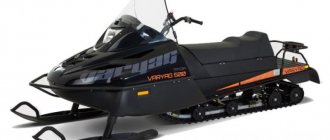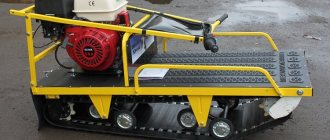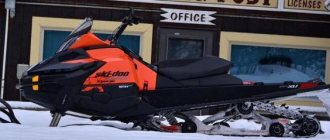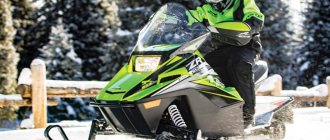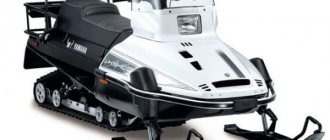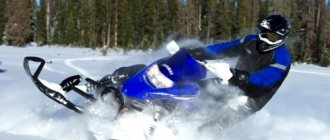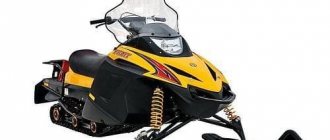Is snow a problem? No problem if you have a snowmobile! If you live somewhere in a warm region (Sochi or Crimea, for example), your only chance to see the workings of a snowmobile is through wildlife documentaries or James Bond films. If you live closer to Siberia, snowmobiles (often called snow cars) will be as familiar to you as scooters are to people living in the south.
Considering how useful snowmobiles are, it's hardly surprising that engineers spent much of the early 20th century developing the ultimate machine for driving on frozen terrain. The small, lightweight modern snowmobile first appeared in the 1960s thanks to pioneering Canadian engineer Joseph-Armand Bombardier, who named his machine Ski-Doo. So how do these little snow machines actually work? Before you buy a snowmobile, we recommend that you understand its design!
What is a snowmobile
A snowmobile has much more traction on snow than a motorcycle, using a large, wide track with deep ruts. A belt drive and clutch system transfers power from the engine (at the center of the machine) to the tracks at the rear. Compare this to Bombardier's early snowmobile design in early 1944 (pictured below) and you'll see that the basic idea hasn't changed much.
Think about a regular motorcycle: you have a heavy engine in the center, with the rider balanced on top, and two narrow wheels with rubber tires directly in front and behind. In practice, mopeds on snow and ice are incredibly dangerous and it is best to avoid such extreme riding: the steering wheel is incredibly slippery, and there is a high risk of your bike rolling right out from under you. The problem is that relatively little of your scooter actually touches the road - just two tiny patches of rubber under the front and rear tires - and that's simply not enough to give you good traction and grip.
If you had to rebuild a bike for snowy terrain, what would you change? You can place your skis at the front to distribute your weight and give you reasonable steering control. A wide track at the rear would provide you with plenty of speed and traction no matter what terrain you're riding on. What you would end up with would be something like a modern snowmobile. It's very similar to a motorcycle, with the engine in roughly the same location and power sent to the rear wheel drive via a belt.
What kind of snowmobile device
A snowmobile is more than just a motor, skis and tracks. Here are some details and parts of the snow car:
- Skis - lift up to stop the car from sinking into the snow as it moves forward. They also provide efficient steering.
- Ski handles are additional metal loops on the front of the skis used to tow or pull the machine out of the snow.
- The front bumper provides some protection from damage.
- Shock absorbers are often made of lightweight but strong aluminum and absorb energy as the skis hit them due to rough terrain.
- Hood - Fiberglass or hard polycarbonate plastic front cover. Softens absorbing energy to soften impacts.
- Engine Ventilation - Remember that your snowmobile has a gasoline engine that requires air to burn fuel. There are usually vents on the front and sides of the hood.
- Dashboard Instruments - Latest sleds feature LCD instrument panels including a speedometer (showing current and average speed), rev counter, odometer, engine thermometer, and compass.
- Windshield - measures approximately 12-60 cm (5-25 inches) from top to bottom. Tall windshields like this are good for handling in difficult terrain and provide a certain amount of rollover protection. Lower windshields are better for racing.
- Side reflector for a little extra visibility.
- Leg support and protection from icy winds.
- Throttle - Expect a top speed of around 110 km/h (70 mph).
- Brake Lever - Controls the hydraulic disc brakes that stop the rear tracks. Apparently the front skis don't have brakes.
- Seating – Most snowmobiles have seating for one or two people. Some models have heated covers.
- Track Wheels - These do not provide power, but rather allow the track to spread over a larger area of ground, effectively providing a longer trajectory and better traction. Also used for braking. They have a diameter of about 14 cm (5.5 inches).
- Track - sometimes referred to as "endless tread". Typically 34-40 cm (13.5-16 inches) wide and made from durable materials such as carbon fiber or Kevlar.
- Star Wheel - The rear wheel is usually about 18 cm (7 inches) across.
- A snow flap - like a mudguard on a motorcycle, stops the snow shooting from the back onto the people following behind.
- Luggage Rack - Most snowmobiles have a fuel tank here.
- Tail and brake light.
- Back of the seat.
- Headlight - equipped with one or two powerful 60-watt bulbs with lenses to focus the beam.
- Rear bumper.
- Back plate – for protection against snowdrifts.
- Mirror.
- Fuel tank - holds about 40 liters (10.5 gallons) of gasoline and allows you to travel 300 km (200 miles) without refueling. Typical fuel consumption for snowmobiles is about 10-20 liters per 100 km (10-20 mpg).
- Wind deflectors - help protect your hands from freezing in cold air. For the same reason, handlebar snowmobiles usually have grip heaters.
- The engine is usually a 600cc two-stroke or 1200cc 4-stroke engine (similar to a mid-sized motorcycle). Power is transferred from the engine to the rear drive system by a simple V-belt.
- Rear shock absorber and suspension.
Preparation
Before you start making a snowmobile, you need to calculate the basic parameters of the device. If you are a bit of a design engineer, then it is appropriate to make a drawing of the unit. In principle, all snowmobiles are designed the same and simply. Your task is to make a reliable device modeled after all other variants of this class of vehicle.
What you will need for production:
- Pipe for the frame, for pendants and other frame elements.
It was experimentally found that the optimal pipe diameter is 40 mm. If you are using a profile, then 25 x 25 mm will be enough. Wall thickness – 2 mm. With smaller parameters, the resistance of the device to deformation will be reduced. If they are large, the car will become heavier, which, accordingly, will affect the already not brilliant driving characteristics.
- Wheels with rubber on the axle.
Wheels from ATVs (small models with a wheel diameter of 30-40 cm), some carts, etc. are suitable. A total of 2 axles with 2 wheels on each are required.
- V-belts or conveyor belt.
The main element of the "caterpillars". The optimal thickness is 3 mm. This is enough for stability and wear resistance.
They are used to make lugs - the second element of the “caterpillars”. The optimal diameter is 40 mm with a wall thickness of 5 mm.
- Propulsion system.
As a rule, they use an engine, a carburetor, or a fuel tank from a motorcycle.
- Transmission mechanism.
As a rule, they use sprockets and a chain from a motorcycle, and sprockets from snowmobiles. Drive shaft from any unit, suitable in size.
- Guide skis.
It is optimal to take skis from another snowmobile. Since this element must be as reliable as possible, designed for the load of the unit itself, plus the driver and possible passengers.
As a rule, they use a motorcycle handlebar, respectively, with a gas handle and a cable.
- Platform, seat, body.
In principle, you can do without a platform by attaching the seat(s) and the body (optional) directly to the frame. But sometimes an additional platform is constructed on the frame, for example, from wooden boards, which provide slight cushioning, allow you to place several seats, and at the same time lightly weight the structure.
This element adds additional complexity to the design. Therefore, they often do without it, especially if they plan to drive on uncompacted snow. Shock absorption is installed on the front suspension and driver's seat. You can take it from an old snowmobile or motorcycle.
In addition to those listed above, other standard parts will be required to make a snowmobile: bolts, studs, nuts, hinges.
Who invented the snowmobile
The first snowmobile was designed by Joseph Armand Bombardier and patented in April 1944. Like modern snowmobiles, it has skis at the front for steering and a sophisticated chain tracking system at the rear. The sprockets pull the tracks around, while the intermediate wheels between them provide suspension. The main difference between this vehicle and modern snowmobiles is the large cabin, which can accommodate about 12 people.
Skis, engine, tracks and brakes - the snowmobile seems to be a fairly simple design. However, there is much more hidden under the body kit. If you examine the nearly 500 winter bike-related patents that leading manufacturer Bombardier has filed since 1944, you'll find all sorts of features you never imagined.
For example, powering through wet or deep snow, it is likely that the track will clog, significantly increasing the weight of the drive mechanism and slowing you down. That's why Bombardier developed a snow pusher mechanism in the 1960s, which consisted of spiral grooved wheels to push the snow out as the track passed them.
Some snowmobiles have hidden headlights that are tucked out of the way when not in use. Again, this sounds simple enough, but someone at Bombardier still had to sit down and create a reliable retractable headlamp to get the job done.
As you'd expect, most of Bombardier's patents relate to the track/tread mechanism, suspension, skis and basic frame design - the core features of the sled - but it's interesting to look through their other innovations, which cover everything from quick-release passenger seats and engine turbochargers to the more mundane things like electronic engine lubricants.
Hanging equipment
To make a snowmobile fast and strong, you need to put a good engine on the frame. If you install a low-power motor, then such a structure will move poorly. You also need to correctly calculate the caterpillar. If the area is too small, it will drown in large snow and will not pull even on flat terrain. Particular attention should be paid to skis, which should create good stability and safety when moving at high speed.
DIY rubber caterpillar
To easily move through the snow, it is very important to give your homemade snowmobile a good rubber track. It is not easy to make such a device with your own hands and it is better to purchase it in a store completely with rollers. Installing a standard factory track on a homemade structure is not difficult. To do this, you just have to secure the drive shaft and rollers with bearings to the frame. If your financial situation does not allow you to buy the entire device, then the most expensive parts can be easily made yourself. For this you will need:
- Conveyer belt.
- Plastic pipe.
- Bolts, washers and nuts.
A cheap homemade snowmobile track is usually made using a thin conveyor belt. To do this, plastic pipe blanks are sawed off to fit the width of the rollers. Then they are cut lengthwise into two equal parts and holes are drilled for small bolts. After this, the halves of the plastic pipes are secured to the conveyor belt with bolts, washers and nuts. The caterpillar is ready and further construction needs to begin .
Read also: Gas infrared heater operating principle
Homemade skis
It's no secret that in winter it is much more convenient to travel on deep snow on skis. They also serve well as a control device on a snowmobile. It is not difficult to make a wooden structure, but only strong boards made of birch or oak are suitable for this. They need to be well dried, planed, and then heated and the ends bent. It's no more difficult to make metal skis. To do this, you will need to cut two plates from sheet steel and weld a thin corner on the sides.
In order for the skis to turn freely, metal pipe stands are welded to them. In working condition, they are held in the front bushings of the frame, where they rotate easily .
Washers or large nuts are welded to the top of the racks, into which rods are inserted to control the snowmobile.
The steering wheel itself is easy to make with your own hands, or it’s easier to remove it from an old motorcycle. Thus, all that remains is to install the motor, as well as the driver’s seat, and you can hit the road.
With the arrival of winter, some people successfully replace two-wheeled vehicles with homemade snowmobiles. This equipment is capable of overcoming large snowdrifts and is convenient for moving on snow-covered roads. It is expensive and not everyone can afford to buy it, so many assemble snowmobiles on their own using scrap materials.
How safe are snowmobiles?
Snowmobiles, like motorcycles, are fast and heavy vehicles. In a typical year, 2 million people use snow machines in North America and about 200 of them are killed in accidents and 14,000 are injured (source: https://okami-sport.ru/).
200 deaths may sound like a lot, but we have to put that number in context. Every year, about 150,000 people die from accidental injuries, 33,000 die from falls, and 38,000 people die from motor vehicle accidents.


